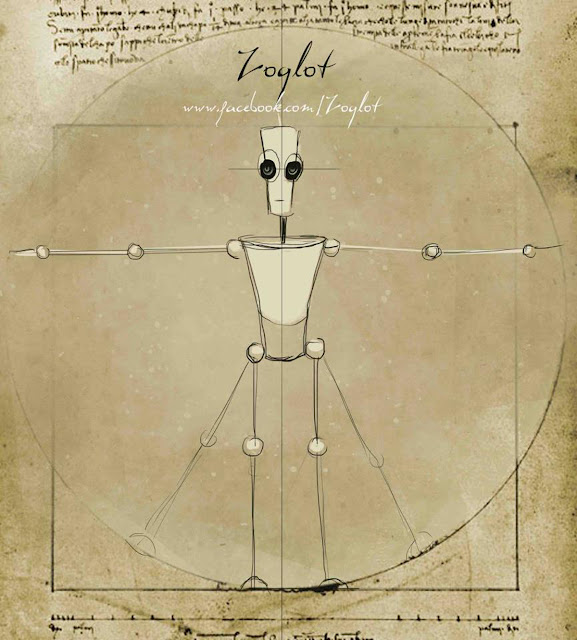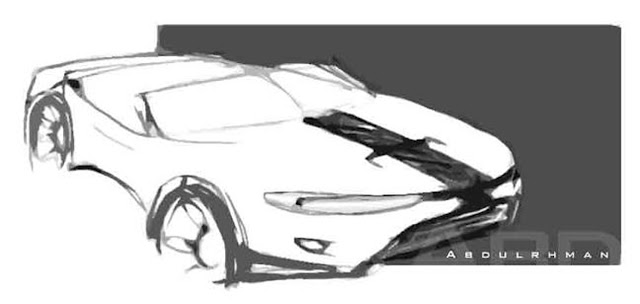Beautiful, Simplistic and a Robot too!
Interview with character designer: E. Abd
ElRahman Zaki
Abd El-Rahman Zaki, student in the Architecture
dept. at Shorouk Academy- Third Year. His interest in art and graphics took him beyond his field of study and into the world of cartoon and caricatures.

When did you start getting interested in drawing
and design? And what are the steps you took to develop your artistic style?
-Back in school, I was greatly influenced
by my art teacher Ehab Mar'i. He gets credit for teaching me drawing in general.
I became fond of the idea of designing cars when I was given a number of video
tapes for the car designer Scott Robertson. I learned a lot from him. After
becoming an architecture student, I found that the artistic aspect of the study
in Egypt has little presence. That's why I try relentlessly to develop my art
by tracking art schools worldwide. I also make sure to keep an eye on many experienced
artists and illustrators. It is watching their masterly work that always
motivates me to keep up raising the level of my work.
Almost certainly what helped me the most
is watching tutorials on Youtube, to be
able to follow visual illustrative of the art of composing image. I learned
that all visual elements are inspired or referenced from nature, accordingly, I
began to study the elements of nature itself - cloud formation, light fall and
reflection on surfaces. Through my personal analysis I was able to deduce many special
notes to use in composing my pieces.




Was your studying art wholly dependent on self-teaching?
-Indeed, but there are many experiences I
acquired from my honored professors at the academy which had intense influence
on developing my artistic study, and some from my classmates as well.


How were you able to balance between your
academic tasks and developing your art?
-Always, like any visual artist, I carry
my sketchbook everywhere and when I find time I get some sketching in, whether
in between lectures or in my spare time.
Did you find difficulties when you shifted
from traditional art to digital painting?
-After developing my free sketching skills,
I was achieving far better quality than that realized through Photoshop. But
when I moved to using the Tablet, it was a huge transition that
influenced the quality and level of my art positively. Nonetheless, I still
seek to develop my capabilities and my artistic level in using it. Usually I
start on Photoshop by creating work lines on a layer and then I commence in
adding detail gradually until I realize a final product.
All artists have begun to use the Tablet.
So it had become a rare occurrence to find someone who still adheres the old pen
and paper. Despite my thinking that this is a setback, looking up to all these
craftsmen gave me some fervor to work with the Tablet, and a
determination to produce a final product with it.
The robot character appears to get your
special attention, so where from did you conceive the concept of this
character?
-Well, originally, I hadn't given it a
name. I remember it was 2010, I was spending sometime at the library when I
found myself sketching this character. And then I redrew it several times in
various poses. It's when I was taken in by the idea that I began to show this
character on facebook. That's when public grew an interest towards this
character, 'Zo'lot', which is the name my friends chose.
I wanted to come out with a simple form
of the robot, and I might have been influenced by some animation movies such as
Robots - 2005. In essence, designing Zo'lot is inspired from the simplest
elements that form a robot.
Most artists have a liking for black and
white pieces. But most, if not everyone, resort to this style to rely on the balance of black and white, and usually black fills are the most prominent in
these works. This trait, however, does not appear in your work, where bright
white is the evident element.
-First of all, I love simplicity in
drawing and shunning exaggeration. Secondly, my target on a personal level was
to learn to draw Zo'lot in many poses, in 3D. For example I would design a
certain body move in a certain pose and then apply it to different poses to
train myself, and repeat that for every move.
Was this simplicity of design a hindrance
in showing expressions and different psychological changes that the character
may go through?
-At all. I love to reach the simplest
forms of facial expressions without overdoing it. That's why you'll find the facial elements of the
character very straightforward, a simple geometric shape (the cylinder for the
head), eyes, mouth, eyebrows and maybe a nose too. Still, the character can
display plenty of facial expressions such as sadness, despair and joy, and
sometimes even bizarre ones like mixed misery and delight.
What are the future steps you're thinking
about concerning the robot character? For example, have you thought of turning it
into 3D for employment into an animation movie? Or to make it be the hero of a
comic book?
-Zo'lot reflects the story of my life.
That's why I designed it, to be able to come back after a long while, look at
my sketches and see the memories of a life passed. But of course, I don't mind
for it to take part in short cartoon movies.
What are some of your favorite animation
movies? And which artists and illustrators do you like to follow the works of?
-I am a good follower of movies but
currently not many names of the ones I love come to mind. However, there are
ones that influenced me such as Wall.E - 2008 and maybe all of Pixar's
movies used to drive me crazy. I appreciate the Disney movies as well, for it conveys
special emotions to the audience. Like a movie of theirs I watched recently
named Paper Man, which left a unique impression on me. Concerning the artists,
there are many but on top of the list comes the Japanese artist Feng Zhu and Scott Robertson.
In the end, what would you like to say to
beginners trying to develop themselves and their capabilities generally?
-Very recently I read an article about
this point in exact, and in the end of it the writer presented four pieces of
advice:
1- Surround yourself with a number of
artists and painters.
2- Maintain your contemplation in nature.
3- Carry your sketchbook with you everywhere
and draw in at least four pages daily.











No comments:
Post a Comment